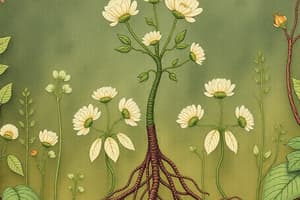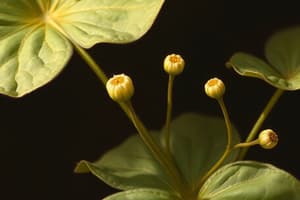Podcast
Questions and Answers
Which structure is responsible for growth in length in plants?
Which structure is responsible for growth in length in plants?
- Stems (correct)
- Flowers
- Leaves
- Roots
What is a function of the tunica in the stem?
What is a function of the tunica in the stem?
- To generate epidermis (correct)
- To generate vascular tissue
- To conduct fluids between roots and leaves
- To provide structural support
What is the a function of the corpus in the stem?
What is the a function of the corpus in the stem?
- To generate epidermis
- To conduct fluids between roots and leaves
- To provide structural support
- To generate vascular tissue (correct)
Which type of stem growth occurs in woody dicots and gymnosperms?
Which type of stem growth occurs in woody dicots and gymnosperms?
What is the main function of the vascular cambium in secondary growth?
What is the main function of the vascular cambium in secondary growth?
Which type of wood is characteristic of cycads?
Which type of wood is characteristic of cycads?
What is the dominant feature of wood in all other woody gymnosperms and angiosperms?
What is the dominant feature of wood in all other woody gymnosperms and angiosperms?
Which type of stem modification is characteristic of xerophytes?
Which type of stem modification is characteristic of xerophytes?
Which type of stem modification is characteristic of bulbs?
Which type of stem modification is characteristic of bulbs?
Which type of stem modification is characteristic of tendrils?
Which type of stem modification is characteristic of tendrils?
True or false: Cycads have the early type of 'manoxylic' wood with alternating bands of xylem and parenchyma?
True or false: Cycads have the early type of 'manoxylic' wood with alternating bands of xylem and parenchyma?
True or false: Monocot stems produce true wood?
True or false: Monocot stems produce true wood?
True or false: Woody gymnosperms and angiosperms have 'pycnoxylic' wood where the cortex and pith are highly reduced?
True or false: Woody gymnosperms and angiosperms have 'pycnoxylic' wood where the cortex and pith are highly reduced?
True or false: Lenticels are found in the bark of trees and are responsible for gas exchange?
True or false: Lenticels are found in the bark of trees and are responsible for gas exchange?
What are the two types of wood found in plants and how do they differ?
What are the two types of wood found in plants and how do they differ?
What are the different stem modifications found in plants and what are their functions?
What are the different stem modifications found in plants and what are their functions?
What is the difference between monocot stems and dicot stems in terms of wood production?
What is the difference between monocot stems and dicot stems in terms of wood production?
Flashcards are hidden until you start studying
Study Notes
Stem Growth and Development
- Stem growth in length is facilitated by the apical meristem.
- The tunica in the stem is responsible for producing new cells, contributing to primary growth.
- The corpus in the stem is where cell differentiation occurs, giving rise to specific cell types.
Secondary Growth
- In woody dicots and gymnosperms, secondary growth occurs through the activity of the vascular cambium.
- The vascular cambium is responsible for producing xylem and phloem tissues, resulting in an increase in stem diameter.
Types of Wood
- Cycads are characterized by manoxylic wood, featuring alternating bands of xylem and parenchyma.
- In all other woody gymnosperms and angiosperms, the dominant feature of wood is pycnoxylic wood, characterized by highly reduced cortex and pith.
Stem Modifications
- Xerophytes often exhibit stem modifications such as succulence or thorns to conserve water.
- Stem modifications in bulbs involve the storage of food and water, allowing plants to survive unfavorable conditions.
- Tendrils are modified stems used for climbing and support.
True or False Statements
- True: Cycads have manoxylic wood with alternating bands of xylem and parenchyma.
- False: Monocot stems produce true wood.
- True: Woody gymnosperms and angiosperms have pycnoxylic wood with reduced cortex and pith.
- True: Lenticels are found in the bark of trees and are responsible for gas exchange.
Wood Types and Stem Modifications
- The two types of wood found in plants are manoxylic and pycnoxylic wood, differing in their structure and cellular composition.
- Stem modifications in plants serve various functions, including water conservation, food storage, and support.
Studying That Suits You
Use AI to generate personalized quizzes and flashcards to suit your learning preferences.




